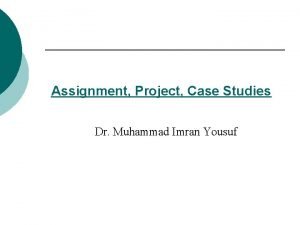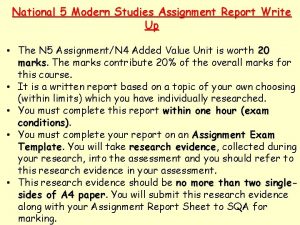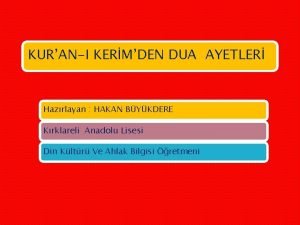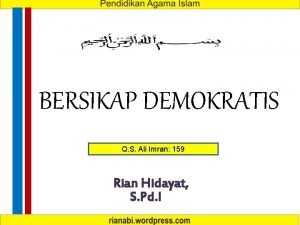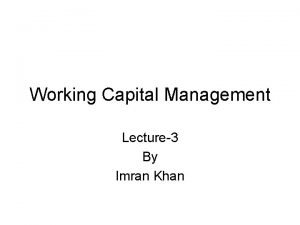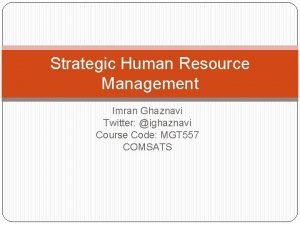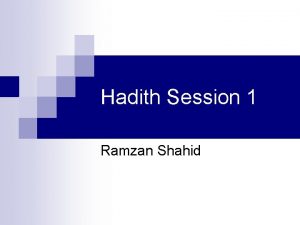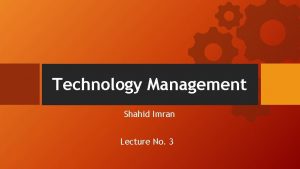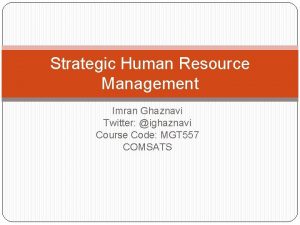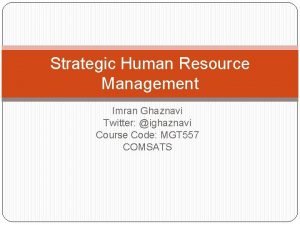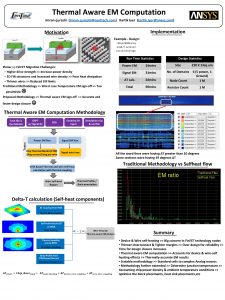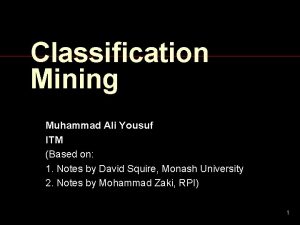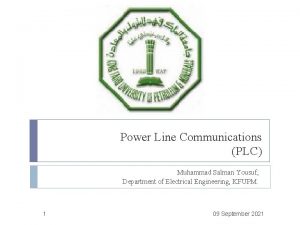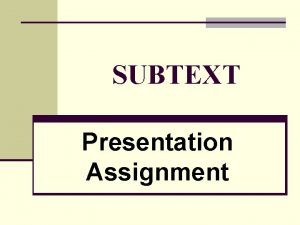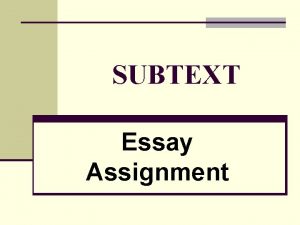Assignment Project Case Studies Dr Muhammad Imran Yousuf




















- Slides: 20

Assignment, Project, Case Studies Dr. Muhammad Imran Yousuf

What we are going to Discuss Outline ¡ ¡ ¡ ¡ HEC Guide lines Purposes of Assignment & alternate assessment tools Phases Support & Demands Evaluation decisions Developing check lists & rubric SOLO Model 2

HEC Guidelines ¡ In each semester, students may be required to appear in quizzes, mid terms, final examination, give presentation, participate in group discussion, and submit projects/ assignments / lab reports.

HEC Guidelines: Weightage Nature of Exam Course with Lab Course without Lab Quizzes 5 – 10% 5 – 15 % Mid Semester Examinations 20 – 30% 30 – 40% Assignments 5 – 10% 5 -10% Practical/Project (if applicable) 10 – 20% - Final Examination - 40 -50%

Purposes of Assignment and other alternative tools ¡ ¡ To meet the limitations of normal assessment tools Scholarly approach

Phases ¡ Planning ¡ Implementation ¡ Evaluation ¡ Feedback

When planning decide how it can: ¡ Fit with main learning objectives ¡ Relate to previous work done ¡ Be new and different ¡ Benefit to students, peers, community, professionals, etc

When planning decide how it can: ¡ Use current topics and current resources ¡ Be completed – in groups, pairs, or individually ¡ Build on students’ previous experience and current skill set

Decide the support & demands students may have: ¡ Identify types of assistance students will require ¡ Contact liaison librarian, community professionals, or other people who can assist you and your students in completing the assignment

Decide the support demands students may have: ¡ When possible, use class time for activities to help students complete the assignment ¡ Decide if students are required to meet with you set times and policies for availability

make evaluation decisions by choosing the: ¡ Assignment length limitations and due dates ¡ Type of feedback to give – written, oral, anonymous ¡ Type of grade required (e. g. , check mark, pass/fail, numeric grade)

make evaluation decisions by choosing the: ¡ Parts to evaluate – effort, research process, thinking process, progress, sequence of assignments, drafts, final products ¡ Weighting of components – how much is each part worth

make evaluation decisions by choosing the: ¡ Policies for possible problems – late or incomplete assignments, missed meetings, poor group work practices, plagiarism

Developing Check List a) (Convey students about stages) o ¡ ¡ ¡ Develop your topic Identify your audience Research Organize and pre-write Draft/write Revise Proofread etc

Rubric Matrix (Levels of learning outcomes) Tasks Stated tasks Levels Beginning Developing Description of identifiable performance characteristics reflecting a beginning level of performance. Description of identifiable performance characteristics reflecting development and movement toward mastery of performance. Prestructural Unistructural Accomplished Description of identifiable performance characteristics reflecting mastery of performance. Multistructural Exemplary Description of identifiable performance characteristics reflecting the highest level of performance. Relational Score

SOLO (Structure of the Observed Learning Outcomes) Model Prestructural The task is engaged, but the learner is distracted or misled by an irrelevant aspect Unistructural The learner focuses on the relevant domain, and picks one aspect to work with Multistructural The learner picks up more and more relevant or correct features, but does not integrate them

SOLO (Structure of the Observed Learning Outcomes) Model Relational The learner now integrates the parts with each other, so that the whole has a coherent structure and meaning Extended Abstract The learner now integrates, so that the coherent whole is raised to a higher level of performance showing expertise within and of itself.

SOLO Model

SOLO Model ¡ At Extended Abstract Level, student is making connections not only within the given area, but also beyond it, able to generalize and transfer the principles and ideas underlying the specific instance.

Developing evaluation criteria
 Dr imran yousuf
Dr imran yousuf Dr muhammad ali yousuf
Dr muhammad ali yousuf Aisha yousuf
Aisha yousuf Sabah in arabic
Sabah in arabic Pengertian puasa arafah
Pengertian puasa arafah Best worst and average case
Best worst and average case Modern studies assignment topics
Modern studies assignment topics Paradigm shift from women studies to gender studies
Paradigm shift from women studies to gender studies Imran iqbal lse
Imran iqbal lse Suction types
Suction types Imran vanker
Imran vanker Hz eyyubun duasi
Hz eyyubun duasi Mehfooz khan
Mehfooz khan Qari imran khan
Qari imran khan Surah ali imran 159
Surah ali imran 159 Imran khan academy
Imran khan academy Imran ghaznavi
Imran ghaznavi Sunnah of prophet muhammad
Sunnah of prophet muhammad Www.imran lecture.com
Www.imran lecture.com Imran ghaznavi
Imran ghaznavi Imran ghaznavi
Imran ghaznavi
